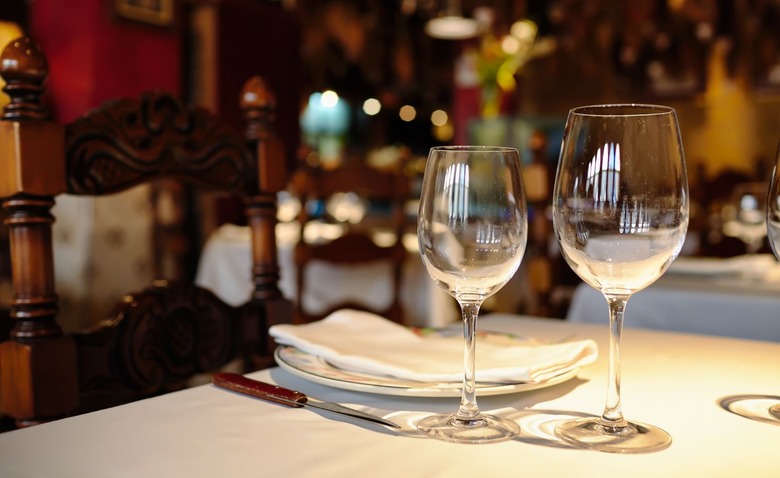Bring Back The White Tablecloth!
Few items have been so ignominiously evicted from restaurants as the white tablecloth — vanished right along with little lamps, pots of flowers, and salad forks. Among the food media of the last decade nothing reeks of "fine dining" so much as a table covered with cloth of any kind — linen, cotton, damask, embossed... "Eat here," tablecloths seem to suggest, "and be prepared to receive a menu all in French, be served by pretentious waiters, and pay a lot for the privilege."
Of course, that is utter nonsense, since tablecloths have been in use for at least the last two millennia, both at home and, in more recent times, in restaurants not just fancy but as modest as a pizzeria. Indeed, up until this century, people might have shied away from a restaurant because it did not have a tablecloth — or at least, as in many bistros, a fresh paper covering, usually over a cloth. (I know of a terrific roast chicken restaurant in Berlin, Die Henne, where one tablecloth is used throughout the evening; they simply turn it over for the next guests.)
The reasons tablecloths, white or otherwise, are so impeccably correct are many:
They are spanking clean and sanitary. A barely wiped bare wooden or Formica table is a festering field for germs.
They are soft and warm to the touch. Your hands don't stick to cloth as they do to wood or other surfaces.
They absorb spilled liquids that otherwise would drip onto your clothes.
They reflect light (unless a restaurateur chooses a dumb color like black).
They add color and contribute measurably to the dining room's design (again unless a restaurateur chooses a dumb color like black).
They are easily crumbed.
They absorb sound — not a small virtue in today's crashingly loud restaurants.
So what's not to like?
Ironically, the war on tablecloths began when some of the very finest of fine dining restaurants, like Jean Georges in New York City, did away with them, insisting that their absence was part of a "design statement." In almost all cases, though, it was nothing more than a matter of trying to save money. I admit that laundry bills can mount for restaurants, sometimes to tens of thousands of dollars per annum. But a lack of tablecloths doesn't seem to reduce the price of a meal. Believe me, your dinner is never cheaper because the restaurant doesn't use tablecloths.
Another early adopter of tablecloth removal was the Judge Judy of TV food competitions, Tom Colicchio, who upon opening Craft in Manhattan announced that it would deliberately not use tablecloths or any other trappings of "formality," because, he said, "I don't think people are interested in eating like that anymore."
Of course, colorful plastic cups, knives, and forks and patterned paper napkins might well be a design statement too and would save restaurants a lot more money — but thankfully we haven't descended that low yet, except on airplanes. Paper napkins do, however, now seem to be far more in evidence than ever before at those new hipster restaurants with counters, open kitchens, and excruciating house music.
Antagonism towards napery has reached the point of banishment in most modern restaurants, however fine the dining or high the price. Consider some of the "hottest" new upscale restaurants to open in the past few months: David Chang's new Majordomo in Los Angeles; Chai Yo Modern Thai in Atlanta; Bellemore in Chicago; The Love in Philadelphia; and just about every hot spot in Las Vegas. All have denuded tables.
Fortunately, a happy number of both old and new restaurants — not all of them fine dining by a long shot — do still put a proper cloth on their tables, among them Oriole in Chicago, Mesa in Dallas, and Le CouCou in New York City, all of which are packed every night.
Of course, I will always be in awe of a cordial ritual that was once performed in many restaurants in America and Europe and still one of the things that draws me back to Sparks Steak House in Manhattan: After the main course is cleared, one waiter begins to roll up the soiled tablecloth while a second waiter rolls a clean one in a graceful unfolding to take its place. It's such a pleasure to watch that it seems as if there should be no other way to set a table. There it lies — white, lightly starched, reflecting the light — before it gets decked with the colors of dessert. What a damn good idea a fresh tablecloth is.
